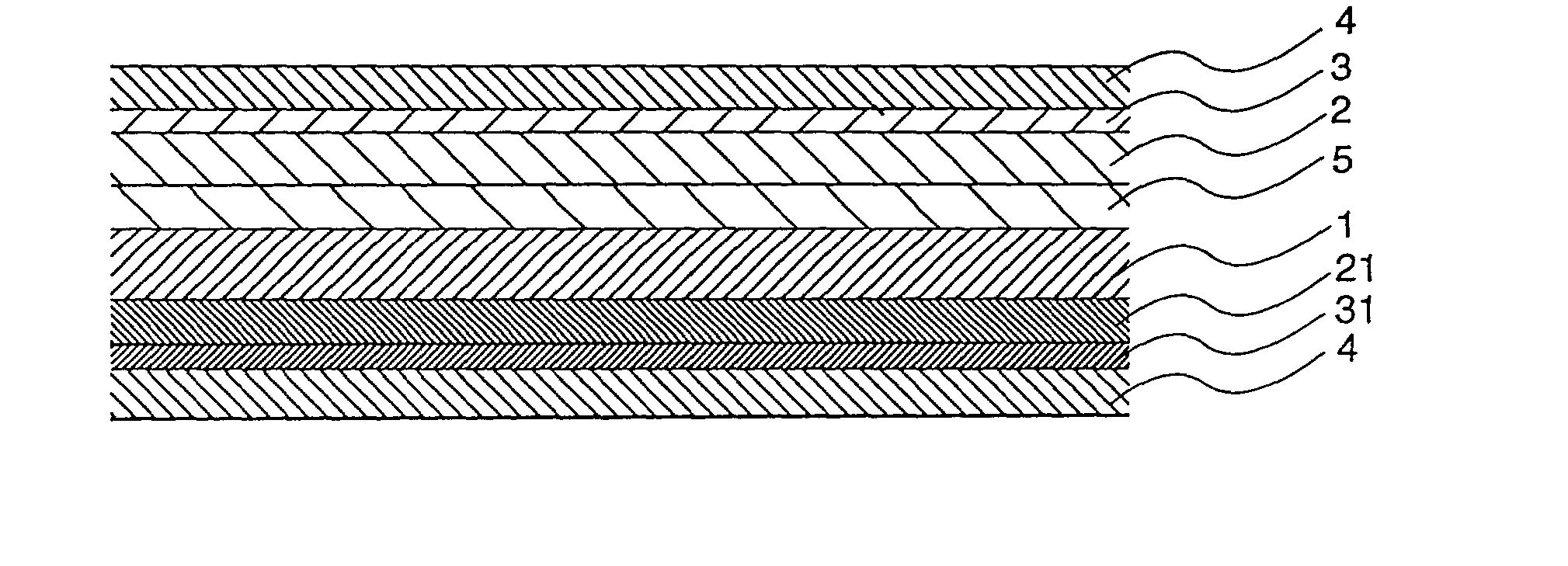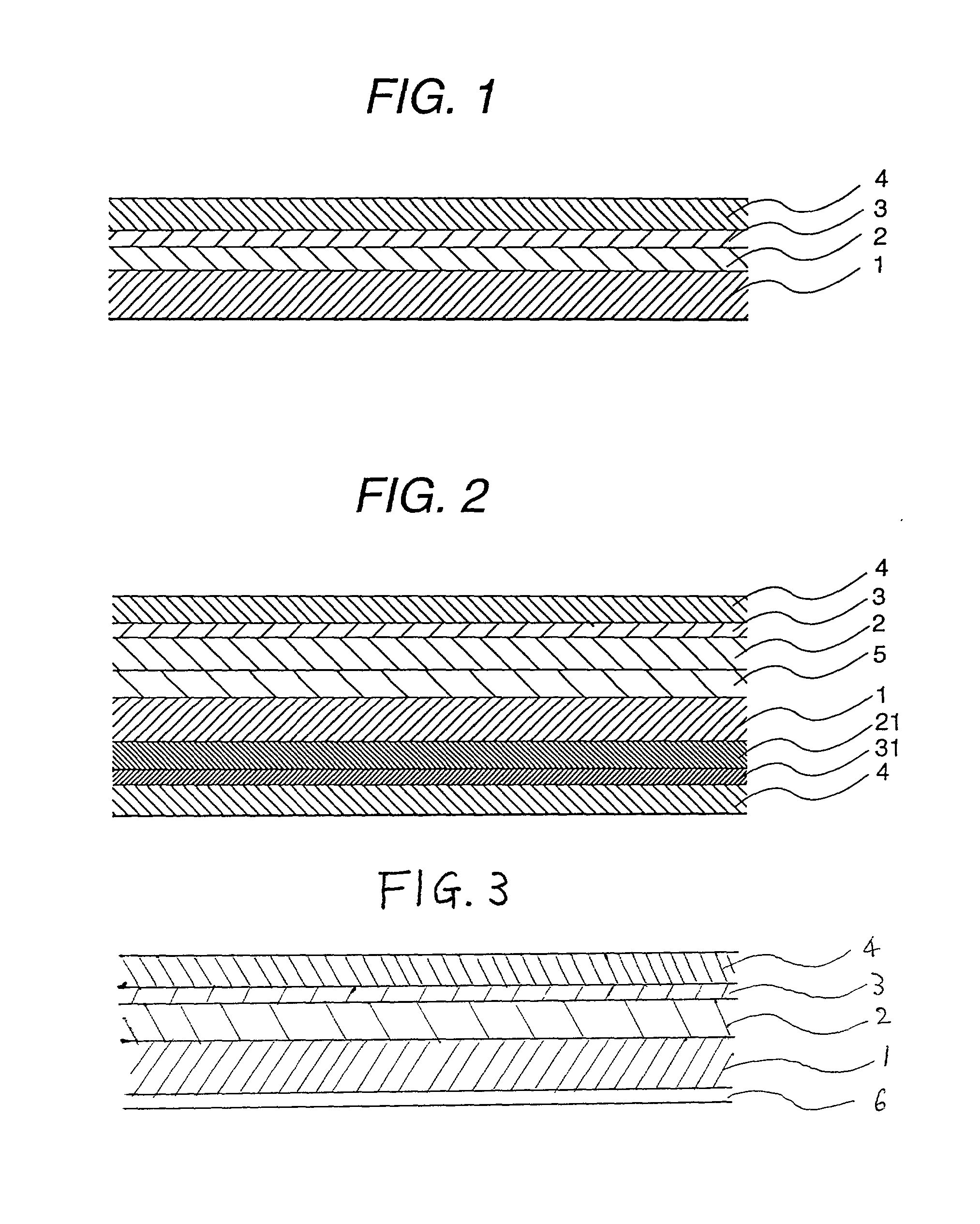Heat-peelable pressure-sensitive adhesive sheet
a pressure-sensitive adhesive and peeling technology, applied in the direction of film/foil adhesives, other domestic articles, transportation and packaging, etc., can solve the problems of remarkable increase in contaminants, unusable wafers in practice, and a large number of extremely fine wafers
- Summary
- Abstract
- Description
- Claims
- Application Information
AI Technical Summary
Benefits of technology
Problems solved by technology
Method used
Image
Examples
example 4
[0090] The same type of the heat-expandable layer having a thickness of 40 .mu.m as used in Example 1 was formed on one side of a PET film having a thickness of 50 .mu.m. A contamination-preventive pressure-sensitive adhesive layer having a thickness of 5 .mu.m was formed on the heat-expandable layer to obtain a heat-peelable pressure-sensitive adhesive sheet.
[0091] The contamination-preventive pressure-sensitive adhesive layer was formed and used as follows.
[0092] 100 Parts of butyl acrylate, 2 parts of ethylhexyl acrylate, 5 parts of acrylic acid, 1 part of methacryloyloxyethylene isocyanate, 0.1 part of 2,2'-azoisobutyrpnitrile and 200 parts of ethyl acetate were blended so as to obtain 200 g of a mixture thereof. The resulting mixture was introduced in a 500 ml three-necked flask-type reactor equipped with a thermometer, stirrer, a nitrogen inlet pipe and a reflux cooling pipe, and stirred for about 1 hour while introducing nitrogen gas thereinto, thereby replacing air inside th...
example 1
COMPARTIVE EXAMPLE 1
[0094] A heat-peelable pressure-sensitive adhesive sheet was prepared in the same manner as in Example 1 except that a pressure-sensitive adhesive layer was not formed on the heat-expandable layer.
example 2
COMPARTIVE EXAMPLE 2
[0095] 70 Parts of n-butyl acrylate, 30 parts of n-ethyl acrylate, 5 parts of acrylic acid, 0.1 part of 2,2'-azoisobutyrpnitrile and 200 parts of toluene were blended so as to obtain 200 g of a mixture thereof. The resulting mixture was introduced in a 500 ml three-necked flask-type reactor equipped with a thermometer, a stirrer, a nitrogen inlet pipe and a reflux cooling pipe, and stirred for about 1 hour while introducing nitrogen gas thereinto, thereby replacing air inside the reactor with nitrogen. The inner temperature was elevated to 60.degree. C., and polymerization was conducted for about 6 hours while maintaining this state, followed by aging at 70.degree. C. for 2 hours in order to completely react monomers, thereby obtaining acrylic copolymer C.
[0096] 2 Parts of an isocyanate crosslinking agent and 35 parts of heat-expandable microspheres (MICROSPHERE F-50D) were blended with a toluene solution containing 100 parts of the acrylic copolymer D obtained a...
PUM
| Property | Measurement | Unit |
|---|---|---|
| Percent by mass | aaaaa | aaaaa |
| Fraction | aaaaa | aaaaa |
| Fraction | aaaaa | aaaaa |
Abstract
Description
Claims
Application Information
 Login to View More
Login to View More - R&D
- Intellectual Property
- Life Sciences
- Materials
- Tech Scout
- Unparalleled Data Quality
- Higher Quality Content
- 60% Fewer Hallucinations
Browse by: Latest US Patents, China's latest patents, Technical Efficacy Thesaurus, Application Domain, Technology Topic, Popular Technical Reports.
© 2025 PatSnap. All rights reserved.Legal|Privacy policy|Modern Slavery Act Transparency Statement|Sitemap|About US| Contact US: help@patsnap.com


